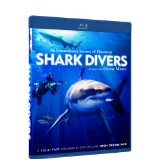“It’s one thing to see a great white shark on television or from the safe confines of a boat. It’s another experience entirely to see the animals in their natural element. There simply is not a single creature on Earth that we’re more afraid of.”
Man’s always had a rather natural, and healthy, fear of sharks, but it was perhaps the 1975 film Jaws that brought all of those primordial fears bubbling to the surface of our pop culture. Since then sharks have taken an almost mythic position in our culture. They invade our fears, but more importantly they fascinate the heck out of us. Young or old, it doesn’t matter. Sharks are the new dinosaurs, and they aren’t going anywhere any time soon. Come face to face with some of the most dangerous creatures on the planet, with a level of clarity and detail that was once reserved only for those who shared their waters.
Danny Mauro produced the series of shark television programs, which focus more on man’s interaction with the creatures and the ecological impact of that interaction. A friend in the reptile business used to use the slogan “Conservation through commercialization”, and this series certainly examines the pros and cons of that relationship.
There are 4 episodes
Shark Divers – This episode directly examines the shark diving tourist industry. One group takes tourists to see large tiger sharks while another takes folks to Mexico to witness great white sharks from a cage. They even take five-year-old kids for the experience. Gives new meaning to the term shark bait, doesn’t it?
Shark Business – Here we see the controversial envelope that is pushed by some shark diving companies and the adrenaline junkies who go on these trips. Here there’s shark baiting, and these folks swim with frenzied sharks all about them. One such diver was attacked by a bull shark and almost died. There have been tourist deaths, and shark behaviorists talk about the pros and cons of the industry. The last of the episode deals with an industry in Washington State to witness the rare 6-gill sharks there and the industry that has sprouted around them.
Whale Sharks – The largest fish in the world is the whale shark, which, like its namesake mammals, is actually a filter feeder and quite gentle. Again the episode looks at the tourist industry that allows folks to swim with these gentle giants. There is a cooperative relationship with scientists who study the animals. One of these researchers from the local Mote Marine near Tampa is a bit annoyed with the tourist industry and feels it has a negative impact on the species. All the while he’s tagged over 600 of these animals. Sounds like overkill to me, and I’m a bit saddened to see wild animals with giant bright tags that make them look like something for sale in a market. There comes a point when you’re really not learning anything new. Do we need to tag them all?
Giants Of San Benedicto – The final episode isn’t about sharks at all, but their cousins the manta rays. These giant rays appear to like people and actually initiate contact with divers. The episode looks at the Georgia Aquarium in Atlanta which contains one along with four whale sharks.
Video
Each of these episodes is presented in its original HD broadcast 1.78:1 format. Obviously many of you only saw full-frame versions depending on when you and your carrier made the HD switch. Most of the images are very crisp. You’ll get to see details on these animals that are truly remarkable. Still the picture is fully 1080i brought to you through an AVC/MPEG-4 codec. Colors are often quite outstanding. There’s a ton of ocean footage here, and some of it is breathtaking. You have to understand that most of this is documentary footage, so some of it is better than others. What you can be sure of is that it hasn’t looked better.
Audio
The DTS-HD Master Audio 2.0 track is pretty solid. There’s a ton of dialog here, and it works well. There’s not a lot of ambient sound here, but I’m not really missing that at all.
Special Features
Nada.
Final Thoughts:
There isn’t quite as much dramatic shark footage here as you’re likely to see on Shark Week. Still, it leans toward a focus on a particular shark industry that allows people to get up and close with some of these frightening creatures. It proves a point that no matter how lucrative shark fishing might be, “A shark is worth more to the economy alive than dead.”




